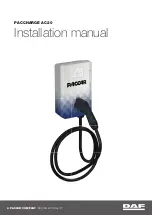
Operating Instructions
3
01334J
TERMINALS FROM BATTERY WHEN CHARGER
IS ON. THE RESULTING ARCING AND BURNING
COULD CAUSE THE BATTERY TO EXPLODE.
WARNING:
KEEP SPARKS, FLAME, AND
SMOKING MATERIALS AWAY FROM BATTERY.
If the charger must be stopped, set the power
switch to OFF. Then disconnect the AC supply
cord.
4.
Monitor the ammeter for correct charge rate.
The initial charge rate should be approximately
10 amps. If the battery has not been
discharged, or the AC supply voltage is lower
than 100/200 volts, the initial charge rate may be
less than 10 amps.
The charge rate will decrease as the battery
reaches full charge. On a liquid electrolyte
battery, the charge rate will decrease to about 3
amps and remain there until the charger turns
off. As the battery ages, the charge rate may no
longer decrease to the 3 amp finish rate. This is
normal and the charger will still determine when
the battery is charged to its optimum and then
turn off.
An older battery, even though it is properly
charged, will gradually lose capacity and should
be replaced when it will no longer perform as
required.
5.
Charger turns off automatically when battery is
fully charged. Charge time varies with battery
size and depth of discharge. Allow 10 hours for
normal charging. Severely discharged batteries
may require up to 14 hours to be properly
charged and equalized. If the charger operates
for 14 hours and is unable to fully charge the
battery, an internal timer will turn the charger off.
After the charger has turned off, set the Power
switch to OFF, then disconnect the AC supply
cord from outlet.
PROPER CARE OF DEEP-CYCLE BATTERIES
Batteries are subject to severe deep-cycle duty on a
daily basis. For this reason, it is important that only
deep-cycle batteries be used. Although these
batteries are designed to withstand such duty, the
following precautions must be observed to obtain
good performance and maximum cycle life.
1.
Always observe the following personal safety
precautions when working with lead acid
batteries:
a.
Someone should be within range of your
voice or close enough to come to your aid
when you work near a battery.
b.
Have plenty of fresh water and soap nearby
in case battery acid contacts skin, clothing,
or eyes.
c.
Wear complete eye protection and clothing
protection. Avoid touching eyes while
working near battery.
d.
If battery acid contacts skin or clothing,
wash immediately with soap and water. If
acid enters eye, immediately flood eye with
running cold water for at least 10 minutes
and get medical attention immediately.
e.
NEVER smoke or allow a spark or flame in
vicinity of batteries.
f.
Be extra cautious to reduce risk of dropping
a metal tool onto battery. It might spark or
short-circuit battery or other electrical part
that may cause explosion.
g.
Remove personal metal items such as rings,
bracelets, necklaces, and watches when
working with a lead acid battery. A lead acid
battery can produce a short-circuit current
high enough to weld a ring or the like to
metal, causing a severe burn.
h.
NEVER
charge a frozen battery.
DANGER: TO REDUCE RISK OF ELECTRIC
SHOCK,
ALWAYS
DISCONNECT
THE
AC
SUPPLY CORD FROM ITS OUTLET AND THE DC
OUTPUT CORD FROM THE BATTERY BEFORE
ATTEMPTING
ANY
MAINTENANCE
OR
CLEANING OF THE BATTERY.
2.
New batteries should be given a full charge
before their first use because it is difficult to
know how long batteries have been stored.
3.
Limit use of new batteries for first 5 cycles. New
batteries are not capable of their rated output
until they have been discharged a number of
times.
4.
Do
not
excessively
discharge
batteries.
Excessive discharge can cause polarity reversal
of individual cells, resulting in complete failure
shortly thereafter. Limited use of new batteries
will minimize the chance of cell reversal.
5.
CHECK THE LEVEL OF THE ELECTROLYTE
IN CONVENTIONAL LIQUID ELECTROLYTE
LEAD
ACID
BATTERIES
MONTHLY.
MAINTAIN THE PROPER ELECTROLYTE
LEVEL BY ADDING DISTILLED OR PURIFIED
WATER WHEN NECESSARY. Electrolyte
levels lower during discharge and rise during
charge. Therefore, it is mandatory that water be
added to cells ONLY when they are fully
charged; do not overfill. Old batteries require
more frequent additions of water than new
batteries.























